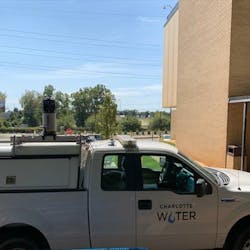Charlotte Water in Charlotte, N.C., needed help.
The city operates the largest water and wastewater utility in the Carolinas and serves around one million customers. Only 30 percent of the nearly 300,000 revenue-generating water meters throughout Charlotte Water’s service area have verified locations. Several sources of information have been used in the past to establish meter sites, including as-builts, Google Street View, aerial imagery and surveys. These approaches were primarily manual and costly — the city spent around $400,000 to locate meters in 2019.
In search of a better process, Charlotte Water sought help from consultants in the Esri Advantage Program, which provides GIS strategies and guidance for challenges within organizations. The consultants suggested an artificial intelligence (AI) solution that could detect water meters in high-resolution imagery.
To test the viability of the concept, Charlotte Water first collected 200 images with a GoPro camera and applied Esri’s algorithms to the images. The results showed that the algorithms could be trained to identify water meters and that the approach would be scalable for a city-wide program; however, the image accuracy was inadequate for delivering precise location information.
Municipalities worldwide are already leveraging street-level imagery as a tool for more efficient municipal planning and asset management. These organizations sometimes have access to a library of images and can analyze existing and previous conditions to get a good overview, especially when maintaining and improving resources.
Creating and maintaining a library of up-to-date images, though, can strain human resources. That’s why mobile mapping is growing in popularity.
What is Mobile Mapping?
Mobile mapping is the fusion of multiple technologies for high-accuracy data acquisition and processing. The technique combines high-resolution cameras and, in some applications, laser scanners with precise positioning. Typically mounted on a car, truck, boat or rail car, the system captures images and 3D points as the vehicle moves through the area of interest. At each exposure, the location and orientation of the camera (and scanner) is recorded.
Aerial imagery provides a good understanding of geography, while street-level imagery validates the aerial data and adds other information on building fundamentals.
“The GoPro could be as much as 30 feet off and the front-facing camera was often blocked by on-street parking, pedestrians, and mailboxes,” said Shannon Martel, GIS manager with Charlotte Water. “The mobile mapping solution was our top choice because we really needed the 360-degree high-resolution coverage, combined with the integrated GPS accuracy.”
Charlotte Water’s mobile mapping system is mounted on a city truck, and meter-reading routes are imported into the MX7 software to guide the mapping. It is a high-level workflow — they collect images with the mobile mapping and then ingest them into an Esri-developed model, which identifies the meter and translates the photogrammetric information into latitude/longitude.
Mobile mapping provides several advantages for Charlotte Water’s high-volume data capture needs. The synchronized navigation and imaging sensors are designed to collect georeferenced images at highway driving speeds for maximum productivity. In addition, driving routes can be imported into compatible software to guide operators and increase their efficiency. The built-in global navigation satellite system (GNSS) and inertial technology, along with the optional Applanix POS LV delivers precise location information. The navigation data is downloaded and processed using Applanix POSPac MMS and Trimble Business Center software to obtain spatial accuracy of 2 to 10 inches.
The MX7 has six cameras for 360-degree collection, which is helpful for seeing around obstacles, and the 30-megapixel (MP) resolution shows fine detail in every image. The camera could capture everything they needed.
Adding Artificial Intelligence
The AI portion of the solution integrates open-source tools with Esri ArcGIS Pro. Charlotte Water uses Esri ArcGIS Pro to map and display multiple GIS layers, such as parcel boundaries and streets, along with the latitude/longitude coordinates of the water meters generated by the model. With the object identification handled automatically, human workers can focus on maintaining the city’s assets and maximizing resources.
“From the perspective of artificial intelligence — specifically the photogrammetry — the combination of accurate GPS information linked to each image, as well as the ability to easily collect images from different angles simultaneously, are key to the success of this type of analysis,” said Wendy Keyes, Esri data scientist.
Until recently, access to complete, current and high-precision map coverage of an area was a luxury, and hosting it incurred significant costs. Modern solutions, however, combine data acquisition, analysis, management and delivery of geospatial data, hosted at no cost. Ultimately, this enables municipal asset managers to make timely, informed decisions in a cost-effective manner.
“The price point and performance of the MX7 was just what we needed, and we hope to repeat the meter data collection every one to two years to keep our database current,” said Martel. “Other departments are exploring using the MX7 images to manage assets like fire hydrants and street signs, which further improves our return on investment.” WW
About the Author: Linda Duffy has worked as a freelance writer since 2003, specializing in geospatial technology.







